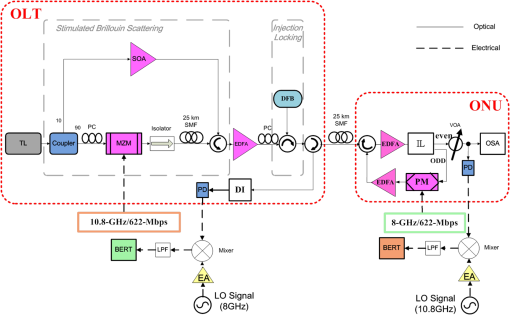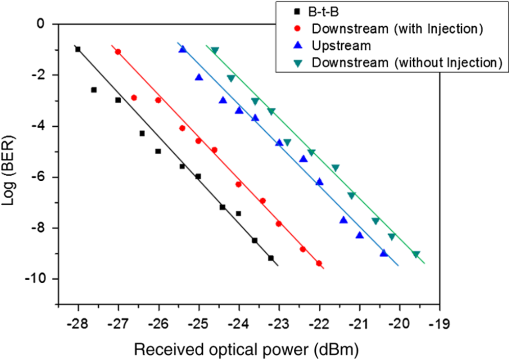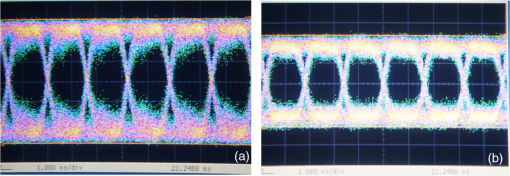|
|
1.IntroductionRadio-on-fiber (ROF) technology can be applied to transmit microwave signals via optical fibers. Communication systems with ROF technology transmit microwave signals across a long distance with high performances which apply a broad bandwidth and the low transmission loss of the fiber. It can also resolve the last mile problem by users. In traditional intensity modulation, an optical carrier is modulated to generate an optical double-sideband format. Over a long-haul fiber transmission, an RF signal causes severe power degradation because of chromatic dispersion.1,2 As such, an optical single-sideband (OSSB) modulation technique must be implemented to overcome RF power degradation. In OSSB modulation, half of the optical spectrum can be removed to provide a dispersion benefit.3–6 Furthermore, OSSB modulation is immunized to fiber dispersion by eliminating one of the sidebands. The modulation scheme also increases the spectral efficiency by twofold. The data rate of in ROF systems can apply to wireless personal area network (WPAN) systems such as high-definition television wireless transmission and high-speed wireless access suitable for IEEE 802.15 WPAN Task Group 3c. In an ROF transmission system, the injection-locked technology plays an important role in improving the performance of the laser diode such as increasing the frequency response, sidemode suppression ratio,7 and reducing the frequency chirp.8 In contrast, bidirectional light wave transmission systems simultaneously transmit downlink and uplink signals. As a consequence, a large crosstalk is produced because transmitted signals disrupt one another.9,10 Optical carrier reuse is widely employed in bidirectional light transmission systems because it is economical and colorless. Optical network installation becomes convenient by replacing a light source in each subscriber premise, and service providers can flexibly manage network resources. Phase modulation (PM) systems utilize optical phase shifting to record signal states which provide high robustness against crosstalk and fiber nonlinearities obtained with a high gain and a low noise figure. Nonlinear effects are the interactions between light waves which can produce noise and crosstalk. The nonlinear effect of stimulated Brillouin scattering (SBS) occurs when the signal power reaches a sufficient level to generate small acoustic vibrations in a glass. Acoustic waves change the density of a material and thus alter its refractive index. A scattered light wave can cause input light degradation because this light wave generates acoustic waves. The Brillouin frequency is approximately 10.8 GHz in the 1550-nm region in a single-mode fiber (SMF). In this paper, we propose a bidirectional transmission system with an OSSB modulation scheme of downlink transmission by employing the SBS effect of the fiber and an injection-locked distributed feedback (DFB) laser to double enhance the OSSB performance. We also reuse the transmitted light to carry uplink data with phase through PM for uplink transmission to avoid transmission signal interference. Our results demonstrate that the performance of the proposed transport system is good. 2.Experimental SetupFigure 1 illustrates the bidirectional ROF transport system based on the SBS effect and injection-locked DFB laser technology. A tunable laser (TL) and a DFB laser are used as a master laser and a slave laser, respectively. The wavelength of the DFB laser is 1546.58 nm. The main parts of a transmitter include a TL source, a microwave signal generator, an RF power amplifier, an RF power splitter, a mixer, a semiconductor optical amplifier (SOA), and a Mach–Zehnder modulator (MZM). A microwave signal is generated at 10.8 GHz by the microwave signal generator then fed into the RF power splitter to split into two copies. One copy of the RF signal passes through the RF power amplifier to increase signal power then is coupled into the mixer. The other copy is supplied to the other RF power amplifier to increase signal power as a local oscillation (LO) signal of the receiver. The nonreturn-to-zero (NRZ) pseudorandom bit sequence (PRBS) length of is mixed with a 10.8 GHz microwave carrier to generate an up-conversion data signal, and the resulting microwave data signal is supplied to the MZM. The TL output signal launches into a 10:90 coupler. Afterward, 90% light is modulated by the microwave data signal at 10.8 GHz via the MZM with an insertion loss of approximately 7 dB. The remaining 10% light is amplified by the SOA and thus acts as a feedback light for the enhanced OSSB modulation. The modulated signal is launched into a 25-km SMF then subsequently interacts with the feedback light from the optical circulator. After the 25-km SMF transmission, an output signal is generated by using an injection-locked technology via a DFB laser to double enhance the OSSB modulation. The output OSSB signal enters an erbium-doped fiber amplifier (EDFA) and amplifies for another 25-km SMF transmission. After fiber transmission, the optical signal enters the EDFA and amplifies, then is separated into two parts by an optical interleaver (IL). In the even channel, the optical spectrum of the optical signal is obtained by using an optical spectrum analyzer (OSA). A photodetector (PD) transforms the optical signal to an electrical signal and performs down-conversion to base band via the mixer for a bit error rate (BER) test. In the odd channel, the optical signal is reused as an uplink light carrier. A NRZ PRBS signal is mixed with 8 GHz to generate an uplink data signal and is modulated by the phase modulator. The modulated light signal enters the EDFA and amplifies to achieve the 25-km SMF transmission. The uplink light signal is subsequently fed into a delay interferometer (DI) to transfer the PM signal into an intensity-modulated signal. Afterward, the optical signal enters the receiver to perform O/E conversion for the BER test. 3.Results and DiscussionFigure 2(a) shows the optical spectrum of the IL obtained by an amplified spontaneous emission (ASE) light source. The IL is used as an optical filter that separates the optical signal into two parts. Figure 2(b) reveals the optical spectrum obtained by using the injection-locked DFB laser. The right sideband is larger by 2.33 dB than the left sideband, because we utilize the SBS effect and the injection-locked DFB laser to enhance the right sideband power. The output spectrum of the right sideband of the modulated signal is amplified, because the SBS effect used in the fiber and the left sideband is attenuated as well. The optical spectrum is likely an OSSB format. The injection-locked DFB laser can doubly enhance the right sideband of the optical spectrum, likewise the sideband power ratio (SBPR) can be increased. Fig. 2Optical spectrum measured by OSA: (a) optical spectrum of IL using the ASE light source, and (b) optical spectrum after injection-locked DFB laser is used. 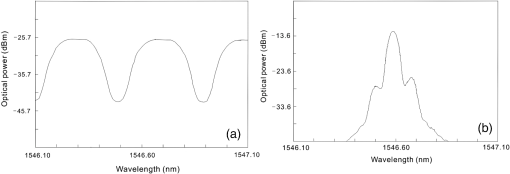 Figure 3(a) displays the optical spectrum of the downlink optical signal in the even channel after the optical signal passes through the IL. The optical signal is OSSB modulated, and the SBPR is . Figure 3(b) shows the optical spectrum of the uplink optical signal in the odd channel after the optical signal is modulated by the phase modulator. Figure 3(c) reveals the optical spectrum of the uplink optical signal after being amplified by EDFA. The transmitted light is successfully remodulated with RF signal to achieve uplink transmission. Fig. 3Optical spectrum of (a) downlink transmission in the even channel passes through the IL, (b) uplink transmission in back of the PM modulator, and (c) uplink optical signal after being amplified by EDFA. 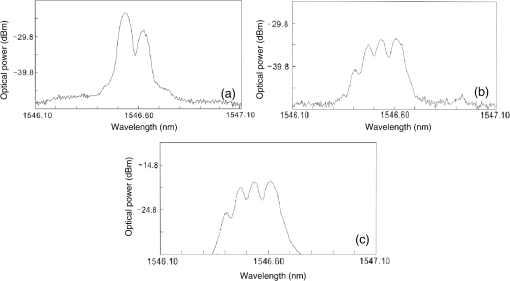 The obtained BER curves as a function of the received optical power are plotted in Fig. 4. The received optical power levels at the BER of are (back-to-back), (downstream with injection), (upstream), and (downstream without injection). A power penalty of approximately 1 dB (downstream with injection) for the fiber link is observed during the BER test for the 25-km SMF transmission. The BER is expressed as follows: where SNR is the signal-to-noise ratio of the system. External light injection reduces the threshold current of the DFB laser and increases the optical output power of the DFB. Moreover, the SBS effect of the fiber and injection-locked technology can increase the right sideband power and can suppress noise distortion, leading to the SNR increase. This increase in SNR improves the performances of the BER for the downlink transmission. PM utilizes optical phase shifting to record the signal state for the uplink transmission which provides high robustness against crosstalk to avoid signal interference with the downlink signal, leading to better BER performances of the system.Figures 5(a) and 5(b) illustrate the eye diagrams of the downlink and uplink transmissions. In Fig. 5(a), the eye diagram indicates the application of the SBS effect and the DFB laser injection for the 25-km SMF transmission. This result confirms that the fiber nonlinearity and injection-locked technology can be utilized to implement OSSB modulation. In Fig. 5(b), the eye diagram of the uplink transmission is achieved when the system reuses the transmitted light through PM to transmit data signals. OSSB modulation and PM are applied respectively to achieve downlink and uplink transmissions and to prevent interference between the obtained transmission data. 4.ConclusionWe propose a bidirectional transmission system based on the SBS effect and injection-locked DFB laser to achieve OSSB modulation in fibers. Two kinds of technologies are detected in the frequency band near 10.8 GHz to enhance the OSSB signal. First, we stimulate a 10.8-GHz RF signal into the modulator and then apply the SBS effect to enhance the right sideband. Second, we use the injection-locked DFB laser to double enhance OSSB modulation for the downlink transmission. We reuse the transmitted light to carry the signal through PM for the uplink transport to avoid signal interference. Using the proposed scheme, we successfully transmit RF signals for the downlink and RF signals for the uplink over a 25-km SMF link. The SBPR is and the power penalty of the system is (downstream with injection). These results indicate that the performances of our proposed bidirectional ROF transport system are good. AcknowledgmentsThis work was supported by the Ministry of Science and Technology of the Republic of China in Taiwan (Grant No. MOST 102-2221-E-131-027-MY2). ReferencesU. Gliese, S. Norskov and T. N. Nielsen,
“Chromatic dispersion in fiber-optic microwave and millimeter-wave links,”
IEEE Trans. Microwave Theory Tech., 44
(10), 1716
–1724
(1996). http://dx.doi.org/10.1109/22.538964 IETMAB 0018-9480 Google Scholar
H. Chi and J. Yao,
“Frequency quadrupling and upconversion in a radio over fiber link,”
J. Lightwave Technol., 26
(15), 2706
–2711
(2008). http://dx.doi.org/10.1109/JLT.2008.927613 JLTEDG 0733-8724 Google Scholar
M. Y Frankel and R. D. Esman,
“Optical single sideband suppressed-carrier modulator for wideband signal processing,”
J. Lightwave Technol., 16
(5), 859
–863
(1998). http://dx.doi.org/10.1109/50.669019 JLTEDG 0733-8724 Google Scholar
U. S. Lee, H. D. Jung and S. Kook,
“Optical single sideband signal generation using phase modulation of semiconductor optical amplifier,”
IEEE Photonics Technol. Lett., 16
(5), 1373
–1375
(2004). http://dx.doi.org/10.1109/LPT.2004.826029 Google Scholar
S. R. Blais and J. Yao,
“Optical single sideband modulation using an ultranarrow ual-transmission-band fiber Bragg grating,”
IEEE Photonics Technol. Lett., 18
(21), 2230
–2232
(2006). http://dx.doi.org/10.1109/LPT.2006.884235 Google Scholar
H. K. Sung, E. K. Lau and M. C. Wu,
“Optical single sideband modulation using strong optical injection-locked semiconductor lasers,”
IEEE Photonics Technol. Lett., 19
(13), 1005
–1007
(2007). http://dx.doi.org/10.1109/LPT.2007.898760 Google Scholar
H. H. Lu et al.,
“Improvement of fiber-optical CATV transport systems performance based on lower-frequency sidemode injection-locked technique,”
IEEE Photonics Technol. Lett., 20
(5), 351
–353
(2008). http://dx.doi.org/10.1109/LPT.2007.915588 Google Scholar
N. A. Olsson et al.,
“Chirp-free transmission over 82.5 km of single mode fibers at with injection locked DFB semiconductor laser,”
J. Lightwave Technol., 3
(1), 63
–66
(1985). http://dx.doi.org/10.1109/JLT.1985.1074146 JLTEDG 0733-8724 Google Scholar
A. Loayssa et al.,
“Design and performance of the bidirectional optical single-sideband modulator,”
J. Lightwave Technol., 21
(4), 1071
–1082
(2003). http://dx.doi.org/10.1109/JLT.2003.810077 JLTEDG 0733-8724 Google Scholar
C. Y. Chen et al.,
“A bidirectional lightwave transport system based on PON integration with WDM VLC,”
Opt. Fiber Technol., 19
(5), 405
–409
(2013). http://dx.doi.org/10.1016/j.yofte.2013.05.006 1068-5200 Google Scholar
BiographyWen-Shing Tsai received his MS and PhD degrees from the Institute of Electro-Optical Engineering, National Taipei University of Technology, Taipei, Taiwan, in 2003 and 2006, respectively. From 2006 to 2011, he worked as an assistant professor at the Department of Electrical Engineering, Ming Chi University of Technology, New Taipei, Taiwan. In 2012, he was promoted to an associate professor. His research interests include optical communication systems and radio-over-fiber transport system applications. Chen-Hong Liao received his BS degree from Lee-Ming Institute of Technology, New Taipei, Taiwan, in 2013. He is currently working toward his MS degree at the Department of Electrical Engineering, Ming Chi University of Technology. His current research interests include community antenna television and ROF transport system applications. |

